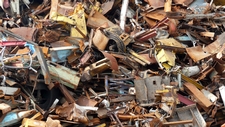Conservation, Disposal and Recycling

TEKS Objective
The student is expected to make informed choices in the use and conservation of natural resources by recycling or reusing materials such as paper, aluminum cans, and plastics.
Essential Understanding
The student conducts classroom and outdoor investigations following school and home safety procedures and environmentally appropriate practices.
Science Background
Recycling: Environmental Protection Agency (website) – There are many benefits to recycling. The EPA outlines multiple good reasons to help students make informed choices.
Recycling
Environmental Protection Agency, www.epa.gov
Reduce & Reuse: Environmental Protection Agency (website) – Conservation of resources means reducing the amount of materials we consume and reusing things that we can. Find more information about the benefits of conserving resources.
Signature Lesson
In Search of Recyclable Plastic: Wonderville (website) – An awareness of different types of recyclable plastics is the encouraged by having students collect and record items from home made from this material. This will help them to make informed choices about recycling or reusing plastic materials.
In Search of Recyclable Plastic
Wonderville, www.wonderville.ca
- Supporting Lessons
- Extensions
- Assessment Ideas
- Literature Connections
- Related
TEKS - Additional Resources
Supporting Lessons
Recycling: Discovery Education (website) – Students will understand that biodegradable materials are those capable of disintegrating easily in nature. They then brainstorm and diagram a useful biodegradable product.
Recycling
Discovery Education, www.discoveryeducation.com
Water Conservation: Penn State University (website) – In this lesson, students keep track of the amount of water they consume during the day and make a poster to boost water conservation awareness.
Elaboration Lessons and Extensions
Trash Art: Environmental Protection Agency the Quest for Less Guide (PDF) – Students collect trash from home and images from magazines to create murals illustrating how much waste is produced. This lesson can be found on pages 59-61.
Assessment Ideas
Waste Race: Environmental Protection Agency The Quest for Less Guide (PDF) – Set up a relay race for students to demonstrate their understanding of reusable, recyclable, compostable or disposable waste. This assessment activity is found on pages 201-202.
Literature Connections
Why Should I Recycle? Green, Jen (ISBN-13: 978-0764131554)
Temperature: Heating Up and Cooling Down. Stille, Darlene (ISBN-13: 978-1404803459)
The Lorax. Dr. Seuss (ISBN-13: 978-0394823379)
Additional Resources
Recycling Lessons and Activities for Students: Kitsap County Washington (PDF) – Activity pages, a reading list, and vocabulary focusing on recycling can be incorporated into your recycling lessons.
Recycling Lessons and Activities for Students
Kitsap County Washington, www.kitsapgov.com
TEKS Navigation
Grade 3
Need Assistance?
If you need help or have a question please use the links below to help resolve your problem.

Comments